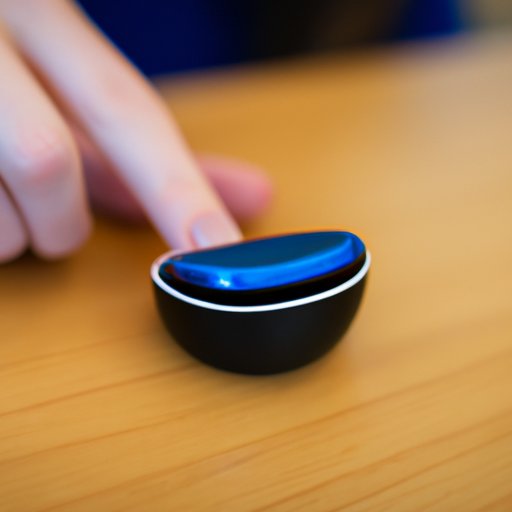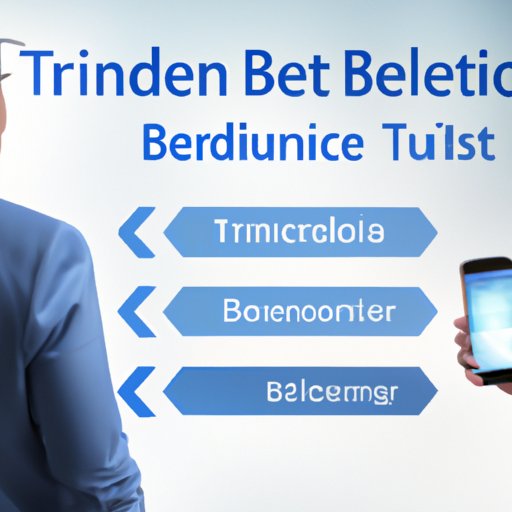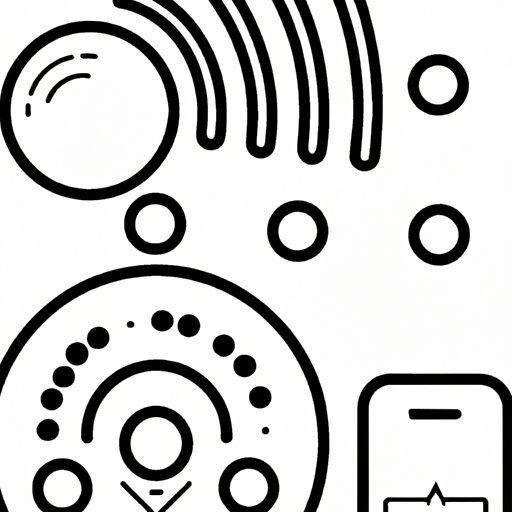Introduction
Bluetooth technology is a type of wireless communication that enables two or more devices to establish a connection without the need for cables or wires. It is used to transmit data between these devices, such as computers, phones, tablets, and other electronic gadgets. The concept of Bluetooth was first introduced in 1994 by Ericsson, a Swedish telecommunications company, and has since become one of the most popular wireless communication technologies worldwide.

Exploring the Basics of Bluetooth Technology
The development of Bluetooth technology began in 1989 with the goal of creating a short-range radio link between mobile phones and their accessories. The name “Bluetooth” was chosen to honor King Harald Blåtand (Bluetooth in English), who unified Denmark and Norway in the 10th century.
History and Development of Bluetooth Technology
In 1994, Ericsson proposed the idea of creating a universal wireless protocol that could be used to connect a variety of different devices. This proposal eventually led to the creation of the Bluetooth Special Interest Group (SIG) in 1998. The SIG is an industry group that oversees the development and promotion of Bluetooth technology.
In 1999, Bluetooth 1.0 was released. This version of Bluetooth had a range of up to 10 meters and a data transfer rate of 721 Kbps. Since then, newer versions of Bluetooth have been released, including Bluetooth 2.0 (2004), Bluetooth 3.0 (2009), Bluetooth 4.0 (2010), Bluetooth 5.0 (2016), and Bluetooth 5.2 (2020).
Technical Specifications of Bluetooth Technology
The latest version of Bluetooth, Bluetooth 5.2, has a maximum data transfer rate of 2 Mbps and a range of up to 800 meters. It also supports a variety of different protocols, including Classic Bluetooth, Low Energy Bluetooth, and Bluetooth Mesh. Additionally, Bluetooth 5.2 has improved power efficiency, allowing devices to run for longer periods of time on a single charge.
How Bluetooth Technology Works
Bluetooth technology uses radio waves to transmit data wirelessly between two or more devices. These devices must be within a certain proximity to each other in order to establish a connection. Once a connection is established, data can be sent back and forth between the devices.
Components of a Bluetooth System
A Bluetooth system consists of three key components: a Bluetooth transceiver, a Bluetooth controller, and a Bluetooth profile. The Bluetooth transceiver is responsible for sending and receiving data via radio waves. The Bluetooth controller manages the process of establishing and maintaining a connection between two or more devices. Finally, the Bluetooth profile defines the rules and procedures for data transmission.
Overview of Data Transmission Process
Data transmission over a Bluetooth connection begins when one device sends out a signal that is picked up by another device. The two devices then exchange a series of messages in order to authenticate each other. Once authentication is complete, the two devices are connected and data can be exchanged.
Advantages and Disadvantages of Bluetooth Technology
Bluetooth technology offers several advantages, such as low cost, low power consumption, and easy setup. However, there are also some drawbacks to using Bluetooth, such as limited range and potential security risks.
Benefits of Using Bluetooth Technology
One of the main benefits of using Bluetooth technology is its low cost. According to a study conducted by the University of California, Berkeley, “the cost of Bluetooth technology is significantly lower than that of other wireless technologies, such as Wi-Fi.” Additionally, Bluetooth technology is highly energy efficient, allowing devices to run for longer periods of time on a single charge. Finally, Bluetooth is relatively easy to set up and use, making it ideal for those who are new to wireless communication.
Drawbacks of Bluetooth Technology
Despite its many advantages, Bluetooth technology also has some drawbacks. One of the main issues is its limited range. While newer versions of Bluetooth have a range of up to 800 meters, the signal can still be blocked by walls or other obstacles. Additionally, Bluetooth connections are vulnerable to security risks, such as man-in-the-middle attacks. As such, users should take extra precautions when connecting to unfamiliar devices.
Applications of Bluetooth Technology
Bluetooth technology is used in a wide variety of applications, from consumer electronics to medical devices. It is particularly popular in the automotive industry, where it is used to connect vehicles to smartphones and other devices. Other common uses of Bluetooth include streaming music, transferring files, and syncing devices.
Common Uses of Bluetooth in Everyday Life
Bluetooth technology is widely used in everyday life. For example, it is used to connect headphones and speakers to smartphones, tablets, and other devices. Additionally, many cars now come equipped with Bluetooth, allowing drivers to make hands-free calls while driving. Finally, Bluetooth is often used to control smart home devices, such as lights and thermostats.
Examples of Industries Utilizing Bluetooth
Bluetooth technology is also used in a variety of industries. For instance, it is used in healthcare to connect medical devices, such as glucose monitors and heart rate monitors. Additionally, Bluetooth is used in retail to enable contactless payments and streamline checkout processes. Finally, Bluetooth is used in the manufacturing industry to track production and improve safety.

Future Trends in Bluetooth Technology
Bluetooth technology is constantly evolving and new developments are being made all the time. Some potential future trends in Bluetooth technology include improved security measures, increased range, and faster data transfer speeds. Additionally, Bluetooth will play a key role in the development of the Internet of Things (IoT), enabling devices to communicate with each other wirelessly.
Potential Developments in Bluetooth Technology
In the near future, we can expect to see improvements in security measures, such as the introduction of stronger encryption protocols. Additionally, the range and speed of Bluetooth technology will likely increase, allowing devices to communicate over greater distances and transfer data more quickly. Finally, new standards will be developed to ensure compatibility between different types of devices.
The Role of Bluetooth in the Internet of Things (IoT)
Bluetooth technology will play an important role in the development of the Internet of Things (IoT). By connecting devices wirelessly, Bluetooth will enable the creation of complex systems that can monitor, control, and automate various tasks. This will open up new possibilities for businesses, allowing them to collect and analyze data more efficiently and create more personalized experiences for their customers.
Conclusion
In conclusion, Bluetooth technology is a type of wireless communication that enables two or more devices to establish a connection without the need for cables or wires. It is used for a variety of applications, from consumer electronics to medical devices, and has many advantages, such as low cost, low power consumption, and easy setup. Additionally, Bluetooth will play a key role in the development of the Internet of Things (IoT). In the future, we can expect to see improvements in security measures, increased range, and faster data transfer speeds.
Overall, Bluetooth technology is a useful and versatile tool that has revolutionized the way people communicate and interact with technology. As technology continues to evolve, so too will Bluetooth, opening up new possibilities for businesses and consumers alike.
(Note: Is this article not meeting your expectations? Do you have knowledge or insights to share? Unlock new opportunities and expand your reach by joining our authors team. Click Registration to join us and share your expertise with our readers.)
